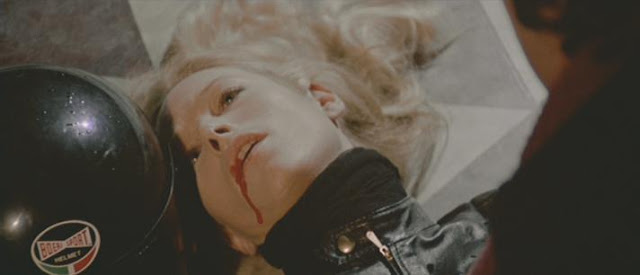There’s no bad movie like a bad Italian movie (♪ like no bad movie I know ♪).
Michele Soavi is proof of this, because he directed one of the all-time greats with StageFright (Deliria), a sort of slasher/sort of giallo/all of a movie where the killer wears a giant owl mask and uses a chainsaw. It’s glorious and stupid and one I revisit often. Right around the same time that killer owl was cutting up stage actors, another Italian director named Lamberto Bava was directing a similarly chaotic movie called Demons (Dèmoni) — the gold standard when it comes to terribly amusing Italian horror. And this movie, about a theater audience whose exhibiting horror film about demons inadvertently raises real demons that begin possessing and/or tearing apart cinemagoers, would naturally spawn a “series.” Demons 2 highlights the same level of disaster, this time in a high-rise apartment building, but somehow without the same level of enjoyment. Officially, the Demons series would be done, but unofficially, further sequels would be made. (Italians could make fake sequels like no one else.) Among them would be The Church (aka Demons 3), and The Sect (aka The Devil’s Daughter…aka Demons 4). Except for the basic concept of demonism, neither film has anything to do with the Demons series (boo!), but when it comes to the histrionics of poor Italian horror filmmaking, they are all kindred spirits (yay!). (And in case you were desperate to know, there are TWO MORE unofficial Demons 3’s: Bava’s own unrelated television effort, The Ogre, released on video as Demons 3: The Ogre, and Umberto Lenzi’s Black Demons, which is exactly what you think it is, and which I need in my life ASAP.)
When compared to the official Demons movies, The Church is actually pretty competent, adhering to a more broad and typical horror concept. What I mean is that it makes sense. Mostly. The Church is also more close-knit with the Demons series in that it’s more overtly about demonic possession and drippy, gooey monsters. Though it features too many characters, some of whom serve absolutely no purpose (sorry, but, I’m looking right at you, Asia Argento), The Church at least embraces a more standard horror experience, even if it does feature a little demon fucking by its ending.
Director Michele Soavi is a genuine whizz with the camera, getting to show off a little flare that falls by the wayside in The Sect and his far more entertaining (for all the wrong reasons) StageFright. He even manages a handful of eerie images, mostly having to do either with hallucinations of the devil himself (maybe) or a horde of possessed church personnel watching his second coming (ewww) as the camera rushes by them in the bowels of the church basement. But, except for some moody gothic atmosphere, along with a few gonzo moments of violence (a woman being decapitated in the film’s Crusades-era prologue and her head being kicked around by horses was a goddamn delight), The Church is still a pretty lackluster experience. Typical in Italian horror from this decade, everyone has been redubbed, even if they were speaking English on set to begin with, making every performance awkward and emotion-free.
Unlike Soavi’s StageFright, which was full-on nuts and only out to spill some blood and dazzle the audience with its preponderance of mystifying set pieces, The Sect (aka The Devi's Daughter — don't forget now!) is out to proffer a more “mature” experience, with an emphasis on mystique peppered with psychedelic hallucinations and dream sequences. And one might argue, “What’s wrong with maturity?” Well, I’ll tell you: sometimes it’s boring. Really boring. And that’s what The Sect is: really boring. I know there are an alarming amount of Italian horror fans out there who would tear me asunder for even suggesting such a thing, but, as they say, if it walks like a duck that’s boring and talks like a duck that’s boring, that’s one boring fucking duck. Speaking of ducks, and in spite of The Sect’s insistence on maturity, it still boasts a few moments of pure absurdism with which Italian horror can be riddled — to throw out just a couple examples, there’s the heroine’s nightmare where she’s pecked apart by the fakest looking bird you’ve ever seen, or the scene where a pet bunny rabbit goes channel surfing with a remote control.
What is this? Why is this? What’s happening?
Kelly Curtis, the sister of Jamie Lee Curtis you’re just now finding out not only exists but actually acted in the ‘80s and ‘90s (she even had role in Trading Places), proves in The Sect that she shouldn’t be acting. Of course, I won’t profess to be an authority on this second Curtis and maybe she’s decent in her own right. Perhaps it was the curse of the Italian horror film, as American actors in Italian productions often offer shaky performances. But based on The Sect…yeesh. Really, The Sect as a whole…yeesh.
Keeping up with Italian horror franchises can be tough because they often deviate to an alarmingly complicated degree depending on the territory in which you're trying to watch them. (See the Zombi series for proof of this, which is so chaotic that its wiki entry provides a helpful graph showing which unrelated Italian movies that happen to contain zombies are considered official Zombi entries depending on the country that produced them.) One thing is for certain: Demons, the crazed, cocaine-addled monster flick that started it all, is still the final word on this sub-genre of Italian horror. Everything that comes after bearing its moniker offer their own share of amusement, but you should definitely tread at your own risk.






















































